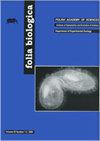The Role of Thymoquinone in Mitigating Carbon Tetrachloride-Induced Hepatocellular Carcinoma in Rats: Targeting the CHOP-1/JNK/P38 MAPK, NFκB/TNF-α/IL-10, and Bax/Bcl-2/Caspase-3 Signalling Pathways
IF 0.8
4区 生物学
Q4 BIOLOGY
引用次数: 1
Abstract
The present study was conducted to evaluate the effect of thymoquinone (TQ) on hepatocellular carcinoma (HCC) in rats. Our study has reported that TQ treatment of experimentally-induced HCC results in the up-regulation of the Jun-N-terminal kinase and p38 mitogen activated protein kinase pathway (JNK/p38 MAPK) and the enhancement of anti-inflammatory, anti-oxidant, and pro-apoptotic machineries. TQ resulted in a significant decrease in the levels of nuclear factor kappa-light-chain-enhancer of activated B-cells (NFκB), tumor necrosis factor-α (TNF-α), and a significant increase in the anti-inflammatory interleukin-10 (IL-10). The pro-apoptotic effect of TQ was demonstrated through stimulating the apoptotic Bcl-2-associated X (Bax) gene and inhibiting the anti-apoptotic B-cell lymphoma 2 (Bcl-2) gene together with increasing the level of caspase 3 and up-regulating the C/EBP homologous protein (CHOP-1) gene expression. TQ treatment also enhanced the activity of the ROS scavenger, superoxide dismutase (SOD), and decreased the level of the lipid peroxidation product malondialdehyde (MDA). TQ-dependent suppression of HCC was associated with the up-regulation of JNK/p38 MAPK, enhanced CHOP-1 expression, and subsequently increased Bax gene expression.胸腺醌在减轻四氯化碳诱导的大鼠肝癌中的作用:靶向CHOP-1/JNK/P38MAPK、NFκB/TNF-α/IL-10和Bax/Bcl-2/Caspase-3信号通路
本研究旨在评价胸腺醌(TQ)对大鼠肝细胞癌(HCC)的影响。我们的研究报道,TQ治疗实验诱导的HCC导致Jun-N-末端激酶和p38丝裂原活化蛋白激酶途径(JNK/p38 MAPK)的上调,以及抗炎、抗氧化和促凋亡机制的增强。TQ导致活化B细胞的核因子-κ轻链增强子(NFκB)、肿瘤坏死因子-α(TNF-α)水平显著降低,抗炎白细胞介素-10(IL-10)水平显著增加。TQ通过刺激凋亡的Bcl-2相关X(Bax)基因、抑制抗凋亡的B细胞淋巴瘤2(Bcl-2)基因、增加胱天蛋白酶3水平和上调C/EBP同源蛋白(CHOP-1)基因表达来证明其促凋亡作用。TQ处理还提高了ROS清除剂、超氧化物歧化酶(SOD)的活性,降低了脂质过氧化产物丙二醛(MDA)的水平。TQ依赖性抑制HCC与JNK/p38 MAPK上调、CHOP-1表达增强以及随后Bax基因表达增加有关。
本文章由计算机程序翻译,如有差异,请以英文原文为准。
求助全文
约1分钟内获得全文
求助全文
来源期刊

Folia Biologica-Krakow
医学-生物学
CiteScore
1.10
自引率
14.30%
发文量
15
审稿时长
>12 weeks
期刊介绍:
Folia Biologica (Kraków) is an international online open access journal accepting original scientific articles on various aspects of zoology: phylogeny, genetics, chromosomal studies, ecology, biogeography, experimental zoology and ultrastructural studies. The language of publication is English, articles are assembled in four issues per year.
 求助内容:
求助内容: 应助结果提醒方式:
应助结果提醒方式:


